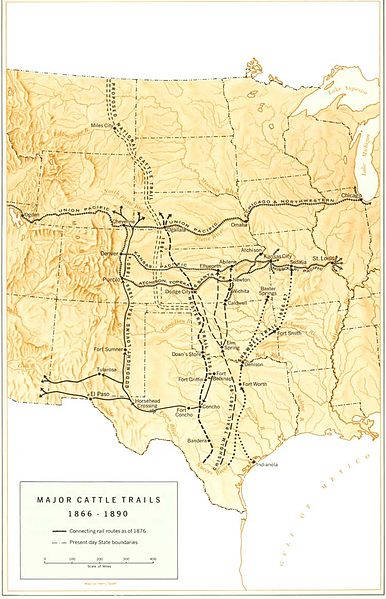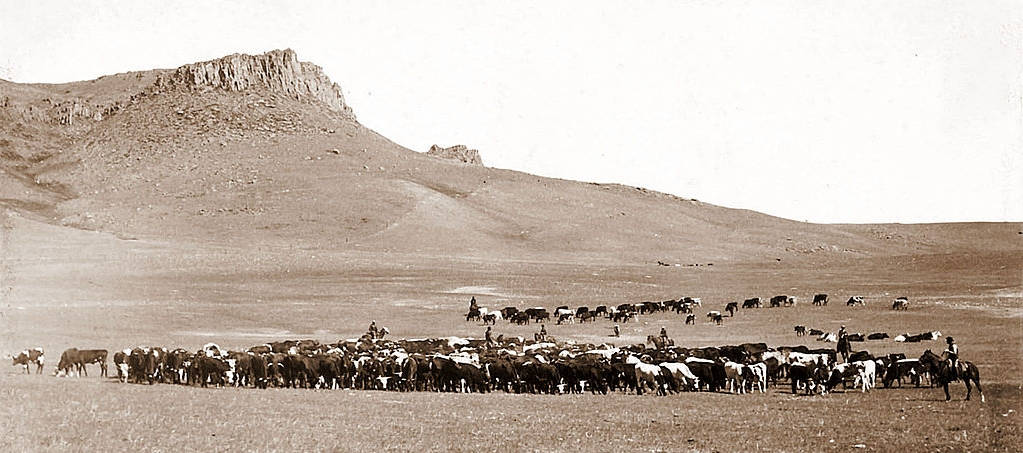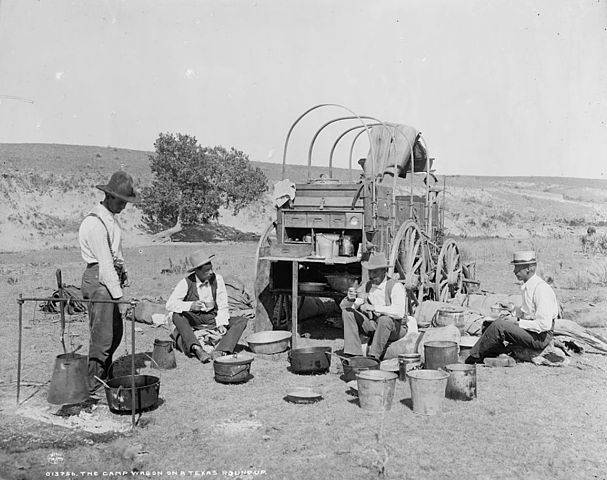Working Cowboy: Life On The Cattle Drive
After the Civil War, food supply, particularly beef, was in great demand in the North. Ranchers saw this as a lucrative opportunity. They bought calves at about $4 a head which they could raise and sell up North for $40, even more. This re-energized the cattle industry and provided new job opportunities for the working cowboy.

The steers will be sold upon reaching their destination and the cowboys can ride back home.
Movies and Western novels romanticize the adventures of a long-distance cattle drive. Many picture it a fun and exciting work, riding with buddies on open range by day, eating hearty meals, and sleeping under starry skies at night. It’s time to separate fact from fiction about life on the cattle drive for a working cowboy.
Fiction: Cattle raising was started by the Americans
Fact: It was the Spaniards who introduced cattle ranching in colonized Mexico in the 1500’s. They hired vaqueros to drive their cattle to Texas and New Mexico. After many years, wealthy Texans learned the technique of cattle raising for food and profit. Mexican vaqueros rode into America to seek new opportunities and were hired to tend cattle for ranchers. This marked the beginning of cowboys in America.
Fiction: Working cowboys always carried firearms for gun fighting
Fact: Cowboys working in the cattle drive carried firearms for protection and not for aggression or settling disputes. The firearms deterred likely attacks from marauding packs of coyotes or wolves, as well as bandits and cattle rustlers. The drovers themselves also need to be protected from being shot at by hostile Indians and angry landowners. The guns, however, are mainly used to control the steers in cases when stampede occurs.
Fiction: The working cowboy was trained as a sharpshooter to protect the herd
Fact: Instead of training in gun handling, cowboys who worked as cattle drivers learned the art of the lasso or, in cowboy terms, “roping.” Mastering this art is necessary in managing and controlling livestock during the long drive.
Fiction: Cowboys usually work alone
Fact: In contrast to what films and novels have perpetuated, the solitary cowboy is a myth for the most part. More often, cattle drives with a herd of 3,000 have 8 to 12 cowboys, several wranglers, a trail boss, an assistant (or segundo), and a camp cook. Drovers work together as a team since this makes it easier for them to round up the cattle several times a day for re-counting and sorting.
Fiction: Work seems easy just riding in the open plains
Fact: The working cowboy faces hard work and may risk their lives during a long cattle drive. Cowboys and wranglers have to be on the saddle from the first light of day until sundown. They need to see that the herd is safe from predators and cattle rustlers especially at night. More importantly, they have to watch out for stampede where steers and cowboys could be harmed or killed. There are times when they have to protect themselves from getting shot at by irate farmers and unfriendly Indians.
Fiction: Cowboys in cattle drives sleep comfortably in open range under the stars
Fact: A cowboy’s work is focused on the herd both day and night. Daytime tasks include riding, wrangling, roundups, and generally keeping their cattle safe. Whether on a long drive or on a ranch, they have to keep a sharp eye on their steers. At night, they have to take turns watching over their livestock to ensure that nothing is harmed or lost during the night. They would sometimes sing a soothing lullaby to their cattle to calm them down and prevent the possibility of stampede. When it’s time for them to finally hit the sack, cowboy slept on portable bedrolls that are usually infested with bedbugs. All in all, cowboys on the drive get about six hours of sleep at night, if they’re lucky.
Fiction: Cowboys get their fill of food
Fact: “Cookie” or the camp cook serves bread, coffee, beans, beef, and bacon at the chuckwagon daily during the drive. While food variety is something to be desired, cowboys generally eat only two meals a day, breakfast and dinner. There is always an option for a third meal, but cowboys prefer to eat less. They just eat enough to satisfy their hunger, and not pig out to avoid an upset stomach while on the saddle.
Fiction: Cowboys look squeaky clean like Roy Rogers

Even if they wore wide-brimmed hats, bandannas, long boots, and chaps for protection against the elements, these accessories do little to keep their clothes from the thick dust kicked up by the cattle. They do, however, get a chance to get their much-needed shower and change of clothing once they reach their destination.
End of the line
The long cattle drive had a short run historically. Texas had rail lines by the early 1870’s and cattle can now be delivered by train to their destination. The overproduction of cattle made beef prices drop which resulted in not a few ranchers going out of business. The last straw that finally put an end to the open range cattle drive was the harsh winter of 1886-87 in the West. Thousands of cattle froze to death in some areas that were hit by sub-zero temperatures. This marked the gradual demise of open range job opportunities for the working cowboy.



Very interesting information. Thank you.